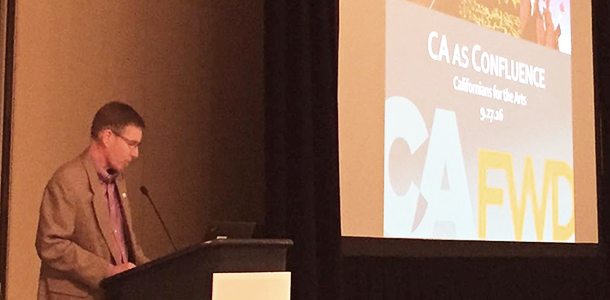
(Photo: Californians for the Arts)
Offering a keynote address that helped connect the dots between California’s arts and culture sector and the visionary work of reforming government and building the state’s economy, CA Fwd's President and CEO Jim Mayer spoke in front of arts leaders and groups gathered from across the state last week.
Mayer closed out the two-day Californians for the Arts Confluence 2016, the arts advocacy conference in Sacramento. The government reform leader advanced the metaphor of “confluence” to discuss the merging, converging and collisions of values that shape California’s past, present and future.
In his talk, Mayer highlighted the creative people that have shaped California’s trajectory, noting that the state “is a place of intense creativity and innovation” and identified some of the artists featured in California Forward’s “Forward Thinkers” campaign.
Confluence was designed to network, build advocacy skills and strengthen the practices of forward thinking arts leaders– the people working on such issues as community development, arts education, cultural equity and rehabilitative services in state correctional facilities.
Bringing the worlds of public interest and arts advocacy together is a necessary step in fostering the cross-sector collaboration that California needs.
“Conferences like these, that assemble participants from within the same field, often remain ‘siloed’ in discussions about their parochial concerns,” said Richard Stein, board president of Californians for the Arts. “Jim offered us a 30,000-foot view of California to better understand the context in which we are working and living, and to consider the opportunities and challenges that we face moving forward.”
It's also important for leaders working on improving California’s economy and governance to better understand the impacts that the creative sector has on economic and community development. Statewide reports and joint committee hearings on the creative economy have taught us that California is home to the nation’s largest population of creative industry workers, and that the sector generates over 9 percent of the state’s gross product while touching 12 percent of its jobs.
In spite of its iconic and powerhouse status as a creative center, California had been last in the nation in arts spending since 2003.
Over the past three years, the state legislature has increased spending, having recognized the urgency of investing in both arts education and community arts programming.
“Creativity and the arts are a central part of our identity as Californians and are key factors in our state's global success,” explained Donn K. Harris, chair of the California Arts Council, arguing investing in the arts “is a cost-effective means to support the growth of healthy, safe, and vibrant California communities.”
The types of programs funded by the California Arts Council parallel some of the directives laid out in California Forward’s Smart Government framework. The creation of cultural districts and the funding of collaborations between the arts and other sectors are also intended to strengthen local economies and foster civic pride and engagement.
And the increase in high-quality arts education spending will help deliver a better-prepared workforce ready for evolving opportunity. A forward-thinking California envisions more of these confluences of the creative and civic sectors, creating partnerships for a thriving golden state.
Tracy Hudak is a writer, artist and business consultant. She is the founder of CreativityWorks, an initiative to help Ventura County harness its creativity to catalyze economic and community success, and the Creative Economy Fellow for CultureLab, an international research database on arts culture and the creative sector.

